 W
WEvents in the year 1847 in Mexico.
 W
WThe Battle of Buena Vista, known as the Battle of La Angostura in Mexico, and sometimes as Battle of Buena Vista/La Angostura, pitted the invading forces, largely volunteers, under General Zachary Taylor and the much larger Mexican Army under General Antonio López de Santa Anna the Mexican-American War. Buena Vista, a village in the state of Coahuila, is seven miles (12 km) south of Saltillo, in Mexico. La Angostura was the local name for the site. The outcome of the battle was ambiguous, with both sides claiming victory. Santa Anna's forces withdrew with war trophies of cannons and flags, leaving the field to the surprised American forces, who had expected there to be another day of hard fighting.
 W
WThe Battle of Cerro Gordo, or Battle of Sierra Gordo, was an engagement in the Mexican–American War on April 18, 1847. The battle saw Winfield Scott's United States troops outflank Antonio López de Santa Anna's larger Mexican army, driving it from a strong defensive position.
 W
WThe Battle of Churubusco took place on August 20, 1847, while Santa Anna's army was in retreat from the Battle of Contreras or Battle of Padierna during the Mexican–American War. It was the battle where the San Patricio Battalion, made up largely of American deserters, made their last stand against U.S. forces. The U.S. Army was victorious, outnumbering more than two-to-one the defending Mexican troops. After the battle, the U.S. Army was only 5 miles (8 km) away from Mexico City. About 50 of the captured San Patricios were later hanged.
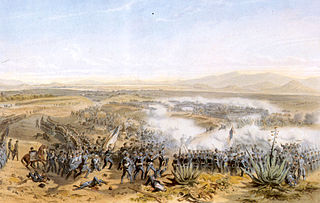 W
WThe Battle of Contreras, also known as the Battle of Padierna, took place on 19–20 August 1847, in one of the final encounters of the Mexican–American War, as invading U.S. forces under Winfield Scott approached the Mexican capital. American forces surprised and then routed the Mexican forces General Gabriel Valencia, who had disobeyed General Antonio López de Santa Anna's orders for his forces' placement. Although the battle was an overwhelming victory for U.S. forces, there are few depictions of it in contemporary popular prints. The armies re-engaged the next day in the Battle of Churubusco.
 W
WThe Battle of Huamantla was a U.S. victory late in the Mexican–American War that forced the Mexican Army to lift the Siege of Puebla.
 W
WThe Battle of Molino del Rey was one of the bloodiest engagements of the Mexican–American War as part of the Battle for Mexico City. It was fought in September 1847 between Mexican forces under General Antonio León against an American force under Major General Winfield Scott at El Molino del Rey on the fringes of Mexico City. The Americans made little progress in this battle, but the Mexican forces were unable to hold them back long enough to prevent the capture of Mexico City one week later.
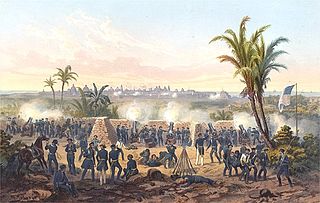 W
WThe Battle of Veracruz was a 20-day siege of the key Mexican beachhead seaport of Veracruz, during the Mexican–American War. Lasting from March 9–29, 1847, it began with the first large-scale amphibious assault conducted by United States military forces, and ended with the surrender and occupation of the city. U.S. forces then marched inland to Mexico City.
 W
WThe Caste War of Yucatán (1847–1901) began with the revolt of native Maya people of the Yucatán Peninsula against the European-descended population, called Yucatecos. The latter had long held political and economic control of the region. A lengthy war ensued between the Yucateco forces in the northwest of the Yucatán and the independent Maya in the southeast. There was regular raiding between them.
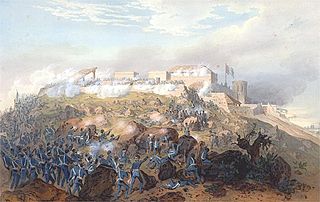 W
WThe Battle of Chapultepec on 13 September 1847 was an assault by invading American forces on a small contingent of Mexican forces holding the strategically located Chapultepec Castle just outside Mexico City. The building, sitting atop a 200-ft (60-m) hill, was an important position for the defense of the city. For the campaign to take Mexico City, of which the Battle of Chapultepec is a part, General Winfield Scott's U.S. Army totaled 7,200 men. General Antonio López de Santa Anna deployed Mexican forces to several sites to defend the capital, so just 880 troops, including military cadets of the Military Academy defended the position at Chapultepec against 2,000 U.S. forces. The Mexican forces' loss opened the way to take the center of Mexico City. In Mexican history, the battle is cast as the story of the brave deaths of six cadets, the Niños Héroes, who leapt to their deaths rather than be taken captive, with one wrapping himself in the Mexican flag. The U.S. has many depictions of the battle from their point of view. Although it lasted only about 60–90 minutes, the battle has great importance in the histories of both countries.
 W
WThe Cienega affair, or the Battle of Cienega Creek, was the last engagement of the Taos Revolt during the Mexican–American War. The battle occurred on July 9, 1847 and was fought between New Mexican insurgents, Pueblo natives and United States Army troops.
 W
WThe Battle of La Mesa was the final battle of the California Campaign during the Mexican–American War, occurring on January 9, 1847, in present-day Vernon, California, the day after the Battle of Rio San Gabriel. The battle was a victory for the United States Army under Commodore Robert F. Stockton and General Stephen Watts Kearny.
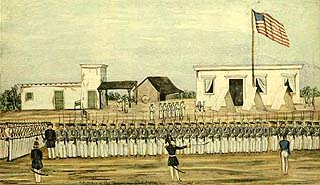 W
WThe Siege of La Paz was a Mexican siege of their own city of La Paz in Baja California Sur. Mexican militia forces attempted to destroy the United States Army garrison, occupying the peninsular town. The siege occurred over a twelve-day period in November and December 1847, at the end of the Mexican–American War.
 W
WThe Las Vegas affair or the Battle of Las Vegas was a battle of the Taos Revolt, fought in July 1847. It was initiated by American troops against New Mexican insurgents at the presidio town of Las Vegas during the Mexican–American War.
 W
WThe Mexican–American War, also known in the United States as the Mexican War and in Mexico as the Intervención Estadounidense en México, was an armed conflict between the United States and Mexico from 1846 to 1848. It followed the 1845 U.S. annexation of Texas, which Mexico still considered Mexican territory since the government did not recognize the Velasco treaty signed by Mexican General Antonio López de Santa Anna when he was a prisoner of the Texian Army during the 1836 Texas Revolution. The Republic of Texas was de facto an independent country, but most of its citizens wished to be annexed by the United States. Domestic sectional politics in the U.S. were preventing annexation since Texas would have been a slave state, upsetting the balance of power between northern free states and southern slave states. In the 1844 United States presidential election, Democrat James K. Polk was elected on a platform of expanding U.S. territory in Oregon and Texas. Polk advocated expansion by either peaceful means or by armed force, with the 1845 annexation of Texas furthering that goal by peaceful means. For Mexico, this was a provocation, but Polk went further, sending U.S. Army troops to the area; he also sent a diplomatic mission to Mexico to try to negotiate the sale of territory. U.S. troops' presence was provocative and designed to lure Mexico into starting the conflict, putting the onus on Mexico and allowing Polk to argue to Congress that a declaration of war should be issued. Mexican forces attacked U.S. forces, and the United States Congress declared war.
 W
WThe Battle for Mexico City refers to the series of engagements from September 8 to September 15, 1847, in the general vicinity of Mexico City during the Mexican–American War. Included are major actions at the battles of Molino del Rey and Chapultepec, culminating with the fall of Mexico City. The U.S. Army under Winfield Scott scored a major success that ended the war.
 W
WThe Battle for Mexico City refers to the series of engagements from September 8 to September 15, 1847, in the general vicinity of Mexico City during the Mexican–American War. Included are major actions at the battles of Molino del Rey and Chapultepec, culminating with the fall of Mexico City. The U.S. Army under Winfield Scott scored a major success that ended the war.
 W
WThe Niños Héroes are a key part of Mexico's patriotic lore, now commemorated by a national holiday on September 13. Several modern Mexican historians contend that parts of the narrative are not factual. The narrative of the Niños Heroes has played an important role in shaping historical memory in Mexico since 1847, a source of pride at the bravery of the martyred boy cadets in defending Mexico's honor, but in the mid-twentieth century, they have also been a means by which the Mexican and U.S. governments have come to a more harmonious relationship.
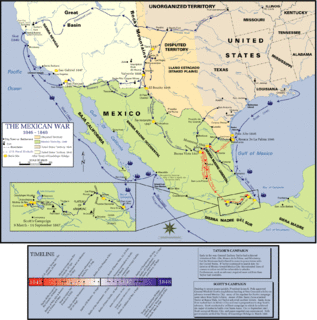 W
WThe Pacific Coast Campaign refers to United States naval operations against targets along Mexico's Pacific Coast during the Mexican–American War. It excludes engagements of the California Campaign in areas of The Californias north of the Baja California Peninsula. The objective of the campaign was to secure the Baja Peninsula of Mexico, and to blockade/capture west-coast ports of Mexico—especially Mazatlan, a major port-of-entry for imported supplies. The resistance of Mexican forces to the north in the Los Angeles area and the lack of ships, soldiers and logistical support prevented an early occupation of the peninsula and the west-coast Mexican seaports. The U.S. Navy attempted blockades of the ports three times before being able to successfully blockade and/or occupy them.
 W
WThe Siege of Pueblo de Taos was the final battle during the main phase of the Taos Revolt, an insurrection against the United States during the Mexican–American War. It was also the final major engagement between American forces and insurgent forces in New Mexico during the war.
 W
WThe Red River Canyon affair, or the Battle of Red River Canyon, was a military action fought during the Taos Revolt of the Mexican–American War. Although the Americans mistakenly called this river by the name "Red", it was actually then and now more correctly called the Canadian River. On 26 May 1847, a detachment of American troops, traveling through northern New Mexico, were attacked by a combined force of Mexican militia with their Apache, Kiowa, and Comanche allies.
 W
WThe Battle of San José del Cabo was a military engagement of the Mexican–American War which took place on two November days in 1847, after the fall of Mexico City.
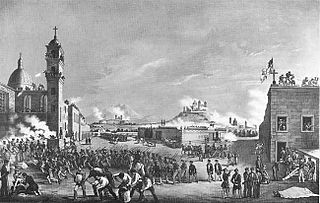 W
WFollowing the Battle of Chapultepec, Santa Anna withdrew his forces from Mexico City, leading a portion in an attempt to take Puebla and cut off Scott's supply route from Veracruz. The Siege of Puebla began the same day Mexico City fell to Winfield Scott and lasted for 28 days before a relief force fought its way into the city.
 W
WThe Battle of Veracruz was a 20-day siege of the key Mexican beachhead seaport of Veracruz, during the Mexican–American War. Lasting from March 9–29, 1847, it began with the first large-scale amphibious assault conducted by United States military forces, and ended with the surrender and occupation of the city. U.S. forces then marched inland to Mexico City.
 W
WThe Treaty of Cahuenga, also called the "Capitulation of Cahuenga," ended the fighting of the Mexican–American War in Alta California in 1847. It was not a formal treaty between nations but an informal agreement between rival military forces in which the Californios gave up fighting. The treaty was drafted in English and Spanish by José Antonio Carrillo, approved by American Lieutenant-Colonel John C. Frémont and Mexican Governor Andrés Pico on January 13, 1847 at Campo de Cahuenga in what is now Universal City, California.